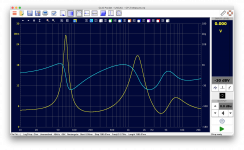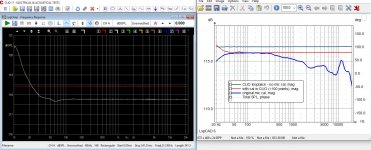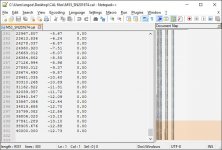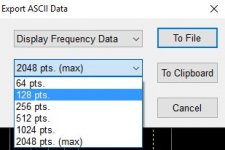SPDIF out could be used if you want to feed the signal to a DAC or a home cinema receiver for example and do room acoustic measurement etc. I assume it was easy/cheap to add so they did.
Happy to report that a range of gaming PCs work flawless with Clio 10/11 and with v low DPC latency. Virtually plug&play with the drivers from Audiomatica.
Producer is Clevo and has a bunch of re-sellers including Eurocom, Sager, XMG and a few others.
I have an older P150SM-A, with W7 x64. Firewire controller is good:
Texas Instruments XIO2213A/B/XIO2221
Producer is Clevo and has a bunch of re-sellers including Eurocom, Sager, XMG and a few others.
I have an older P150SM-A, with W7 x64. Firewire controller is good:
Texas Instruments XIO2213A/B/XIO2221
Has anyone used the SPDIF on the FW-01? Cannot find any documentation for it or it's purpose
Yes! 🙂
CLIO FW Digital Output
The SPDIF RCA connector on the rear panel of the FW-01 is digital output only. It will also work properly with a simple RCA to XLR adapter if you ever want to drive a digital device with AES3 or AES/EBU (two names for the same interface, AES3 is the newer name). If your DUT has an optical digital input, you’ll need something like this to convert CLIO’s digital output to TOSLINK:
Coax to Optical Adapter
I measured the digital output of with an Audio Precision APx515 and it is bit perfect at all (3) sample rates (48k, 96k, 192k).
Gain control of the digital output on the FW-01 is kind of weird until you understand it. You control its output level the same way you control the analog output, but you have to be careful when using the digital output. This is how it works: You set the FW-01 to maximum output (+18dBu), and that will result in the maximum digital output of 0dBFS (you can use the analog outputs simultaneously if you want). You can only adjust the digital output between 0dBFS and -20dBFS. Therefore, once you reduce the FW-01’s output to -2dBu as indicated in the CLIO software, it will jump back up to 0dBFS again! So be careful! Then as you continue to reduce the output level, the digital output will once again go down to -20dBFS and then, reducing the level again will result again in the digital output jumping back up to 0dBFS again.
This will happen (4) times as you adjust CLIO’s output from the maximum +18dBu down to the lowest useable output that is about 80dB below that.
The reason this happens is due to how Audiomatica designed the FW-01. Some of those relays you hear clicking in the unit are analog output gain reduction relays that switch between different resistor networks to smoothly pad or lower the analog output (0.1dB steps are possible by holding the SHIFT key down and pressing "F7" or "F8"). Internally, the digital output to the D/A converters cycles between 0dBFS and -20dBFS while the analog gain circuits adjust to between different groups of resistor pads to allow a continuous analog gain reduction. The FW-01 was designed this way to balance the loss in digital resolution that occurs with digital gain control with the expense associated with employing high resolution, low noise analog gain control. This balance results in more than enough dynamic range for acoustic domain measurements and most electrical domain measurements. If you need to make extremely high dynamic range (120dB+) measurements of very low level signals in the electrical domain, you’ll need to spend north of 10 grand minimum for Audio Precision or the like.
Hope this helps! 🙂
Last edited:
Thanks for the useful info!
One more question on CLIO FW as we have this thread side tracked a bit already....
CLIO manual says
"
CORRECTING THE MICROPHONE RESPONSE
....
GUIDELINES TO REALIZE .CAL FILES
Note: The maximum number of correcting points allowed is 100.
The example below shows a sample text file created to store the microphone
frequency response:"
But what does it do if there are more data points? Would it start from low frequency and stop when it gets to 100 lines or? ... I'm wondering if this might mean that there will be no correction at high frequency in end at all (and thats where it is needed generally).
One more question on CLIO FW as we have this thread side tracked a bit already....
CLIO manual says
"
CORRECTING THE MICROPHONE RESPONSE
....
GUIDELINES TO REALIZE .CAL FILES
Note: The maximum number of correcting points allowed is 100.
The example below shows a sample text file created to store the microphone
frequency response:"
But what does it do if there are more data points? Would it start from low frequency and stop when it gets to 100 lines or? ... I'm wondering if this might mean that there will be no correction at high frequency in end at all (and thats where it is needed generally).
Good question! I don't know. Yet. 🙂
Any reasonable measurement mic is going to be flat up to at least 1kHz. Mic calibration files tend to have data above that point. Any data not included in the file is fine, CLIO simply ignores that range and doesn't modify the response.
Since mic calibration files begin with the lowest correction frequencies, my guess would be that the highest frequencies AFTER the 100th data point will be ignored, if they exist.
If you have a mic calibration file in ASCII format with more than 100 data points, please post it or send it to my email address (available in link below) and I'll test it and let you know exactly what happens.
Thanks!
Any reasonable measurement mic is going to be flat up to at least 1kHz. Mic calibration files tend to have data above that point. Any data not included in the file is fine, CLIO simply ignores that range and doesn't modify the response.
Since mic calibration files begin with the lowest correction frequencies, my guess would be that the highest frequencies AFTER the 100th data point will be ignored, if they exist.
If you have a mic calibration file in ASCII format with more than 100 data points, please post it or send it to my email address (available in link below) and I'll test it and let you know exactly what happens.
Thanks!
Langston:
Here is an assortment of mike cal files. Most are over 100 lines in Praxis text format (essentially the common format it seems). First is the frequency, second is level and 3rd is phase. These were created by Kim Giridin comparing to a B&K 4135.
I hope to have the time to set up to do the same here (I have a recent calibration B&K 4135 and an extended response driver). Above 30 KHz it really doesn't work to calibrate in free field. Just too many things to screw it up.
Is there a script/tool for creating microphone cal files in Clio? Does Clio have phase as a component of the calibration?
Here is an assortment of mike cal files. Most are over 100 lines in Praxis text format (essentially the common format it seems). First is the frequency, second is level and 3rd is phase. These were created by Kim Giridin comparing to a B&K 4135.
I hope to have the time to set up to do the same here (I have a recent calibration B&K 4135 and an extended response driver). Above 30 KHz it really doesn't work to calibrate in free field. Just too many things to screw it up.
Is there a script/tool for creating microphone cal files in Clio? Does Clio have phase as a component of the calibration?
Attachments
Attached are scans of the original calibration in 1980 and the recent calibration of my B&K 4135. There is a lot less data in this file but its enough to generate a suitable correction (not that one is needed given the deviations).
The phase info in the other files is derived from a Hilbert transform.
Also relevant is that the data is only really accurate with the grid off.
The phase info in the other files is derived from a Hilbert transform.
Also relevant is that the data is only really accurate with the grid off.
Attachments
Unfortunately it seems to be exactly the behaviour that it reads 100 lines and just flattens after that. I tried to load this LinearX cal file that has 300 lines...
So everyone - be aware with this. No warnings or indication is given that the cal does not load all of the values! Also it quite puzzles me where the 100 limit comes from. Even CLIO itself exports 64/128/256 etc.
Some of my cal file samples - same thing... most are much more than 100 points.
https://1drv.ms/u/s!AvVPh3wl37NzgZl6VYeJ8DseHtWEUw
I made a 100 point file of the same M53 cal file with Liberty Praxis that is the only tool I know where one can set 100 point export.
Now when I try to reload 100 point file CLIO seems to still apply the same cal with low freq. correction only. I've restarted it multiple time etc. etc. I can only remove the cal or get same as the first broken sample. So seems to me there is another bug that does not update the cal file copy. (I'm running the latest ver of CLIO FW)
So everyone - be aware with this. No warnings or indication is given that the cal does not load all of the values! Also it quite puzzles me where the 100 limit comes from. Even CLIO itself exports 64/128/256 etc.
Some of my cal file samples - same thing... most are much more than 100 points.
https://1drv.ms/u/s!AvVPh3wl37NzgZl6VYeJ8DseHtWEUw
I made a 100 point file of the same M53 cal file with Liberty Praxis that is the only tool I know where one can set 100 point export.
Now when I try to reload 100 point file CLIO seems to still apply the same cal with low freq. correction only. I've restarted it multiple time etc. etc. I can only remove the cal or get same as the first broken sample. So seems to me there is another bug that does not update the cal file copy. (I'm running the latest ver of CLIO FW)
Attachments
Last edited:
Thinking about it, the best would be if CLIO would allow plotting the mic cal file on screen after import like ARTA and REW allow to do. Then one can really check and see for sure that the program did import it correctly. This sort of issue can really brake measurement accuracy behaving like it does today.
Thank you so much Demian and Ergo - both your posts were incredibly helpful!
I imported both sets of mic correction data files into CLIO FW and was happy to see that it handled the scientific notation format that Demian supplied as well as the standard format that the manual illustrates and was in Ergo's files. Phase was also imported correctly - BUT both magnitude and phase are cutoff after 100 data points just like Ergo reported and I noticed CLIO used the last two data points as a simple regression line with which to extend the correction to the Nyquist limit of the measurement. Not good. It's as if you placed a ruler parallel with the last two data points and drew a line from there up to the highest frequency.
Audiomatica is about to get a serious email. I don't like this a bit - you guys rock.
In other news, the B&K data from Demian was fascinating. For no good reason I've always wanted a mic that would go to 100kHz like that. It is interesting that all the data applied to having the protection grid removed from the crazy expensive mic capsule, thus the correction would only be accurate if you did the same during measurement sessions. Maybe this compromise is relevant only at very small wavelengths above the audible spectrum. I have much to learn - audio rocks. 🙂
I imported both sets of mic correction data files into CLIO FW and was happy to see that it handled the scientific notation format that Demian supplied as well as the standard format that the manual illustrates and was in Ergo's files. Phase was also imported correctly - BUT both magnitude and phase are cutoff after 100 data points just like Ergo reported and I noticed CLIO used the last two data points as a simple regression line with which to extend the correction to the Nyquist limit of the measurement. Not good. It's as if you placed a ruler parallel with the last two data points and drew a line from there up to the highest frequency.
Audiomatica is about to get a serious email. I don't like this a bit - you guys rock.
In other news, the B&K data from Demian was fascinating. For no good reason I've always wanted a mic that would go to 100kHz like that. It is interesting that all the data applied to having the protection grid removed from the crazy expensive mic capsule, thus the correction would only be accurate if you did the same during measurement sessions. Maybe this compromise is relevant only at very small wavelengths above the audible spectrum. I have much to learn - audio rocks. 🙂
Last edited:
I know this is foremost a CLIO Pocket thread but I'll add this bit of CLIO QCBOX model 5 knowledge here as well.
After support e-mail exchange with CLIO Italy they sent me a solution. The solution is to remove the 'Load VCP' ticker that is 'on' by default. This is not in the setup instructions available on their page. Maybe this will save some hours of frustration for somebody some day.
😀 😀
It works.
Oh, and another thing. I would suggest to change the voltage prompt from the signal generator from "Input Generator Output level" to "Enter Generator Output Level"
In reference to the QCBox v5 and USB:
This is a huge help - thanks to both ergo and Dragos.
I looked into this and a "VCP" or Virtual COM Port is a feature that allows the USB device to appear as an additional COM port available to the PC. This type of sharing is not the kind of thing that makes sense for a calibrated measurement device designed for professional loudspeaker R&D and QC, so I can see the logic in needing to disable VCP. What isn’t good is the lack of that warning in the installation section of the manual and I’m going to get that changed.
You’re absolutely right, probably a little Italian/English trouble there. Change #2. 🙂
You guys rock.
...After support e-mail exchange with CLIO Italy they sent me a solution. The solution is to remove the 'Load VCP' ticker that is 'on' by default. This is not in the setup instructions available on their page. Maybe this will save some hours of frustration for somebody some day.
😀 😀
It works.
This is a huge help - thanks to both ergo and Dragos.
I looked into this and a "VCP" or Virtual COM Port is a feature that allows the USB device to appear as an additional COM port available to the PC. This type of sharing is not the kind of thing that makes sense for a calibrated measurement device designed for professional loudspeaker R&D and QC, so I can see the logic in needing to disable VCP. What isn’t good is the lack of that warning in the installation section of the manual and I’m going to get that changed.
Oh, and another thing. I would suggest to change the voltage prompt from the signal generator from "Input Generator Output level" to "Enter Generator Output Level"
You’re absolutely right, probably a little Italian/English trouble there. Change #2. 🙂
You guys rock.
Does CLIO pocket have the option to edit the names per curve (now it's numbered)?
Not at present, but I'll shoot that request to Audiomatica. 🙂
What I do is make notes for each measurement in the CLIO Pocket Options tab called "Notes & Print" and save each individual measurement, obviously to a file name that is also descriptive. You can then recall multiple measurements for comparison giving each a different color as you recall them.
A note about colors, it's totally subjective, but I think CLIO Pocket looks best with a dark navy blue background and bright yellow as the primary measurement trace. The comparison trace or overlay colors are also something I spent some time on. I prefer a screen line width of 2 except when I want the fastest possible redraw rate for the real time FFT module, then choose a width of 1.

Hi Langston,
Did CLIO ever come back with answer about the calibration file line count issue. On their website the CLIO FW sw version is still 11.42 so seems no update has been released yet.
I'm eagerly waiting for new info on CLIO FW to CLIO 12/USB upgrade as well of course. Would solve the problem of having to drag out old laptop or using desktop to have the FW.
Did CLIO ever come back with answer about the calibration file line count issue. On their website the CLIO FW sw version is still 11.42 so seems no update has been released yet.
I'm eagerly waiting for new info on CLIO FW to CLIO 12/USB upgrade as well of course. Would solve the problem of having to drag out old laptop or using desktop to have the FW.
Somehow I am dissapointed by the switch to USB interface. True it's more comfortable, but Firewire/Thunderbolt had other advantages over USB.
Modern laptops can handle Clio without a hiccup. I am using a Precision M6800, via the EC34 port. No issues.
Newer laptops with Thunderbolt port can use the same device via the Thunderbolt to FW adapter.
11.42 will be the latest version for the FW-01 interface as I understand.
Modern laptops can handle Clio without a hiccup. I am using a Precision M6800, via the EC34 port. No issues.
Newer laptops with Thunderbolt port can use the same device via the Thunderbolt to FW adapter.
11.42 will be the latest version for the FW-01 interface as I understand.
After measuring several curves I saved the file but after re-opening none of the files were available anymore. Am I doing something wrong here?
After measuring several curves I saved the file but after re-opening none of the files were available anymore. Am I doing something wrong here?
Hello! I'm not quite sure what you mean exactly, but CLIO Pocket will not save multiple traces with a single file save procedure like CLIO 12 will. With CLIO Pocket you need to save each measurement you make to a separate file.
Then you can recall (1) measurement and click on one colored buttons numbered 1-9 to store that trace as an overlay. Then open a second measurement file and store its trace to a different overlay number. You can compare up to (10) measurements in this fashion (the active measurement trace and 9 overlays) and use cursors to measure the differences between each trace.
You can also perform basic math functions on a measurement using another saved measurement as a reference.
Let me know if I missed something! 🙂
- Home
- Design & Build
- Equipment & Tools
- CLIO Pocket


